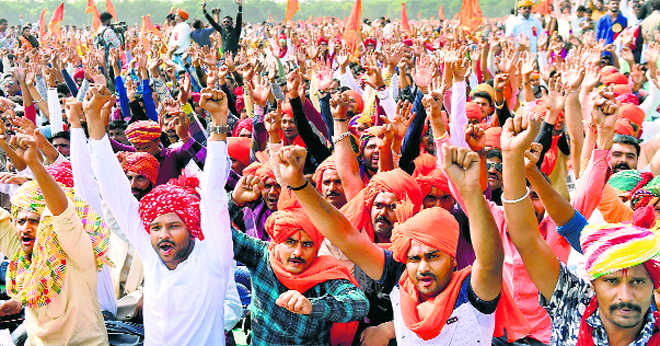Rajesh Kochhar
Honorary Professor, Panjab University, Chandigarh
Acasteist outfit, the Rajasthan-based Sri Rajput Karni Sena's objection to the movie 'Padmavati' is somewhat surprising because the Rajputs acquitted themselves honorably in this period. The Delhi Sultanate was relatively a new thing and the Rajputana rulers were still hopeful of challenging it militarily. They fought valiantly till the end and their women took their own life to protect their honour.
Mughal-Rajput marriages
As time passed, Rajputs became increasingly disadvantaged. Babar defeated the Rajput confederacy led by Rana Sanga of Chittor. His widow Rani Karnavati's appeal to Humayun for help against the Gujarat Sultan failed to elicit any prompt response. The rules of the game changed with Akbar. Rajput rulers became allies of the Mughals, but at a price. They were asked to send their daughters to the imperial harem. The practice lasted 150 long years, from 1562 to 1715.
From Jodha Bai to Indira Kanwar
The first Rajput girl in the Mughal zenana was a daughter of Raja Bharmal of Amber, known variously as Jodha Bai, Hira Kunwai or Harkha Bai, who was married to Emperor Akbar. Given the secular image of Akbar, the marriage has been presented as an inter-religious affair. Movies and television serials have romanticised this particular pair, but the reality, in general, was different. It is noteworthy that Mughal chronicles do not record Hindu names of Rajput wives; they know them only by their Muslim titles. While the Rajput wives in the Mughal harem would probably have met their male blood relatives, it is unlikely that they ever visited their parental home.
The last incidence of a Mughal-Rajput marriage is particularly unsavoury; it belongs to an era when the Mughal power had precipitously declined. In 1715, Maharaja Ajit Singh of Marwar was compelled to marry off his daughter Indira Kanwar to Emperor Farrukhsiyar. The Maharaja showed no fondness for his Mughal son-in-law. He, in fact, was instrumental in Farrukhsiyar's dethronement and assassination. Indira Kanwar was converted back to Hinduism and brought to Jodhpur with all her property. It was the first ever instance of a Rajput princess being "restored to her own people after she had once entered the imperial harem." The daughter was obviously nothing more than a pawn in her father's politicking.
Karni Sena’s aim
The Karni Sena has violently reacted to 'Jodha-Akbar' and 'Padmavati'. One shudders to think of its reaction if someone were to make a movie on Indira Kanwar.
The Karni Sena's avowed aim is to consolidate the Rajput vote with a view to striking a hard bargain at the next General Election. Keeping the vote bank politics in mind, Rajasthan Chief Minister Vasundhara Raje has argued: "Why insist upon a film if it is hurting the sentiments of a particular caste?" Pandering to populism, the governments of Rajasthan, Haryana and MP have banned the film even without waiting for a decision by the certification board.
The Karni Sena president has demanded that the film be cleared by the erstwhile ruling family of Mewar. This is a pernicious principle. Every Hindu has a caste. Historical personalities cannot be considered as the property of their present-day caste descendents. If Maharana Pratap can be a national hero, why can the others not be seen from a general perspective?
History and art
The National Film Certification Board has announced that historians would be included in the panel that views 'Padmavati'. Such a move can serve no useful purpose. History is a tricky subject; it cannot be written without implicating the historian. Not all historical facts are recorded nor are all points of view accommodated. What is considered important today may not even have been considered worthy of notice in the past.
Alauddin Khalji's chronicler Amir Khusro records the jauhar committed by the queens and other women in the Ranthambore Fort which was conquered in 1301. It was the first description of the custom in Persian. Two years later, the Chittor fort was reduced under similar circumstances but no jauhar is mentioned. It will be wrong to conclude from this that no jauhar took place. The absence of mention does not constitute proof of absence. Muslim chroniclers may not have been overly enthusiastic about recording the goings-on in the Rajput camp. It is probable that Amir Khusro's interest was in reporting a new phenomenon to his readers. Once the purpose had been served, there was no need to report the incident again.
If the womenfolk in Chittorgarh did not take their own life, what happened to them? If they had been taken to Delhi, surely the Sultanate historians and chroniclers would have found it worthy of mention. It is pointless to speculate whether Padmini or Padmavati was a real person or not. There would have been a chief queen in Chittor even if we do not know her real name.
Suppose Jayasi had set his epic in Ranthambore rather than in Chittor. There would have been no controversy on the historicity, but the impact of the epic would have been the same as now.
No movie can ever be made based solely on the inputs provided by chroniclers and historians. Even if names, dates and events are authentic, characters will have to be fleshed out, tensions created and drama enacted. As the high court has said, a movie should not be pre-judged.
The decision on its release should be awaited and respected. More importantly, a nation should be able to look its past in the eye without feeling discomfited. It should allow its artistes and creative persons to function in an atmosphere free of fear.
Unlock Exclusive Insights with The Tribune Premium
Take your experience further with Premium access.
Thought-provoking Opinions, Expert Analysis, In-depth Insights and other Member Only Benefits
Already a Member? Sign In Now











